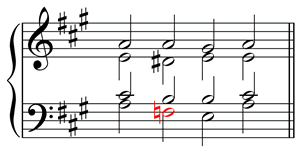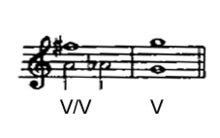In this post, I’ll share with you one of my best tips for achieving a good result in your musical analysis exams.
We can summarize it in a simple sentence: If you are unable to recognize a chord, instead try to recognize it’s function and you’ll get the nature of it.
Let’s see an example. The best way to understand an obscure harmonic passage is seeing the chord progression as a chain of relations in which every single one has a mission. There are a lot of different chords, but only a few chord functions and each one is usually followed or preceded by a certain other function.
OK: let’s suppose you have an odd chord as following one:

At first sight, it is possible that if you are not an advanced student you will do not understand the chord F-B-D#-A and, consequently, you will not understand the cadence properly. However, If you are an advanced student, you will notice that the red chord is an augmented sixth, and probably you also know his different formulas, how to use it, its function, and so on. If you recognized the chord, you will instantly understand its meaning. So, in other words, you discovered its function.
Let’s suppose that you do not even know the existence of something called “augmented sixth”: following these steps you can discover the chord and come to the same conclusion.
- Try to figure out what is happening in the score. As you see, we are in the middle of a cadence which ends V-I. Before the dominant chord, we usually find several options:
— Either a subdominant function or…
— a V/V, which is a secondary dominant. - As we know that the score is in the key of A major, we will see that our chord includes the D# (which in fact is the leading tone of E major, the V grade) and also the natural F, which is a very uncommon note in A major context. You will notice that both accidental notes chromatically tend to the En note, which means that they are driving our ears to the dominant function.
- Then: it is a secondary dominant (as a kind of V/V) or a subdominant related to Neapolitan IInd? Even the theorists do not agree if the chord is one thing or another, and it is not important as the analyst understands the meaning of a passage. The meaning we give to certain progression, or combination of notes, is only a convention. What we must do not fail is his function.


So, to sum up. As you can see, observation is the key to achieve the right solution. Beginners sometimes do not realize that in his musical future they will face musical situations that are totally ambiguous or can be understood in completely different scenarios. Otherwise, the music will be a quite boring repetitive schemas, and very uninteresting. The main goal of a correct analysis isn’t to guess the name of a chord correctly (in fact, there are many chords we can name differently), but to be able to understand its function and make it understandable to an audience.
Prof. Jordi Clapés, musicologist and MA.

